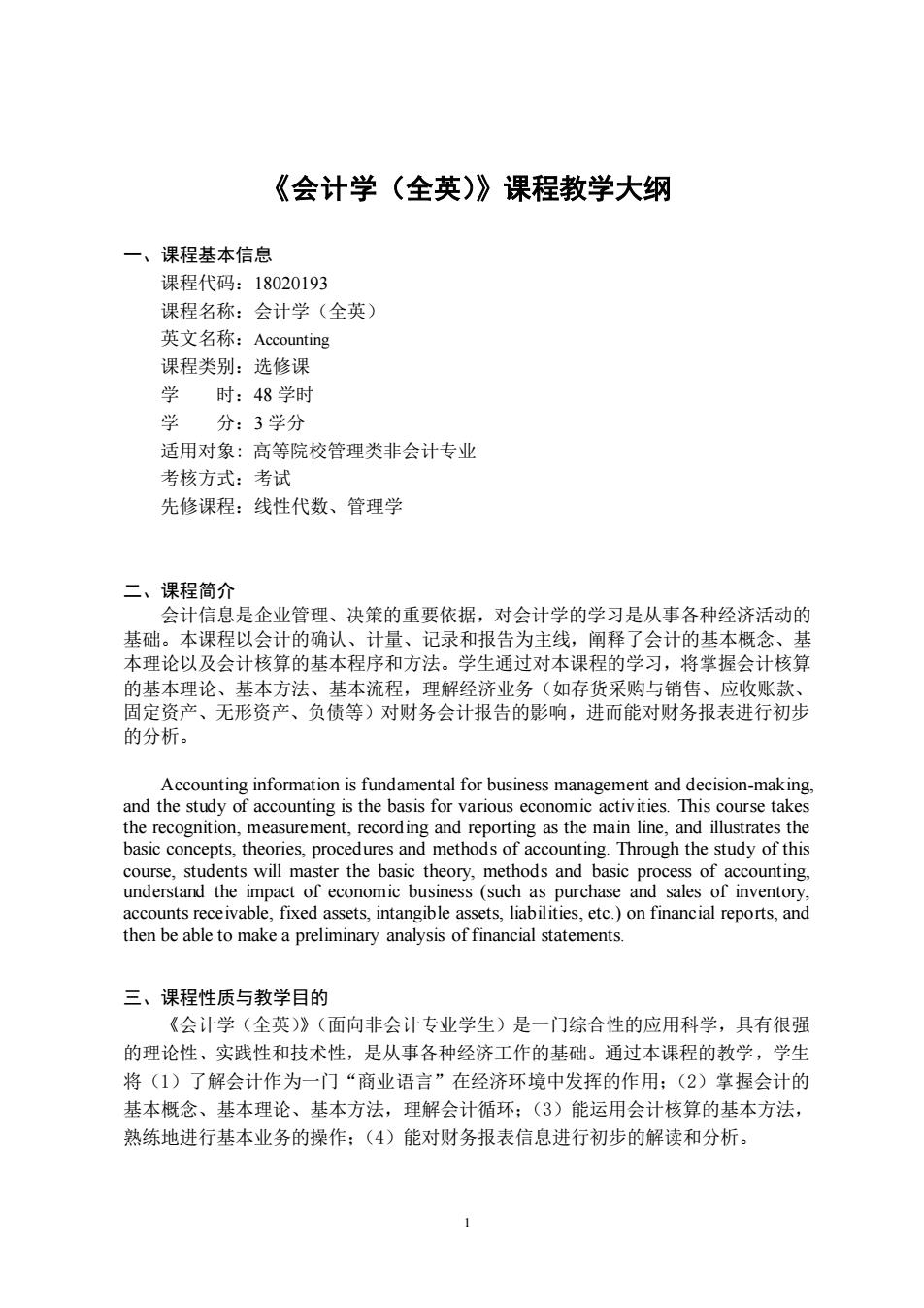
《会计学(全英)》课程教学大纲 一、课程基本信息 课程代码:18020193 课程名称:会计学(全英) 英文名称:Accounting 课程类谢:选修课 学时:48学时 学 分:3学分 适用对象:高等院校管理类非会计专业 考核方式:考试 先修课程:线性代数、管理学 二、课程简介 会计信息是企业管理、决策的重要依据,对会计学的学习是从事各种经济活动的 基础 本课程以会计的确认、 记录和报告为主线 阐释了会计的基本概 本理论以及会计核算的基本程序和方法。学生通过对本课程的学习,将掌握会计核算 的基本理论、基本方法、基本流程,理解经济业务(如存货采购与销售、应收账款、 固定资产、无形资产、负债等)对财务会计报告的影响,进而能对财务报表进行初步 的分析。 ting information is fundamental for business ma agement and decision is the basis for course take th ecord nd orting as the dy act of eco and sales of in accounts receivable.fixed assets.intangible assets.liabilities.etc.)on financial reports.and then be able to make a preliminary analysis of financial statements. 三、课程性质与教学目的 《会计学(全英)》(面向非会计专业学牛)是一门综合性的应用科学,具有很强 的理论性、实践性和技术性,是从事各种经济工作的基础。通过本课程的教学,学生 将(1)了解会计作为一门“商业语言”在经济环境中发挥的作用:(2)掌握会计的 基本概念、基本理论、基本方法,理解会计循环:(3)能运用会计核算的基本方法, 熟练地进行基本业务的操作:(4)能对财务报表信息进行初步的解读和分析。 1
1 《会计学(全英)》课程教学大纲 一、课程基本信息 课程代码:18020193 课程名称:会计学(全英) 英文名称:Accounting 课程类别:选修课 学 时:48 学时 学 分:3 学分 适用对象: 高等院校管理类非会计专业 考核方式:考试 先修课程:线性代数、管理学 二、课程简介 会计信息是企业管理、决策的重要依据,对会计学的学习是从事各种经济活动的 基础。本课程以会计的确认、计量、记录和报告为主线,阐释了会计的基本概念、基 本理论以及会计核算的基本程序和方法。学生通过对本课程的学习,将掌握会计核算 的基本理论、基本方法、基本流程,理解经济业务(如存货采购与销售、应收账款、 固定资产、无形资产、负债等)对财务会计报告的影响,进而能对财务报表进行初步 的分析。 Accounting information is fundamental for business management and decision-making, and the study of accounting is the basis for various economic activities. This course takes the recognition, measurement, recording and reporting as the main line, and illustrates the basic concepts, theories, procedures and methods of accounting. Through the study of this course, students will master the basic theory, methods and basic process of accounting, understand the impact of economic business (such as purchase and sales of inventory, accounts receivable, fixed assets, intangible assets, liabilities, etc.) on financial reports, and then be able to make a preliminary analysis of financial statements. 三、课程性质与教学目的 《会计学(全英)》(面向非会计专业学生)是一门综合性的应用科学,具有很强 的理论性、实践性和技术性,是从事各种经济工作的基础。通过本课程的教学,学生 将(1)了解会计作为一门“商业语言”在经济环境中发挥的作用;(2)掌握会计的 基本概念、基本理论、基本方法,理解会计循环;(3)能运用会计核算的基本方法, 熟练地进行基本业务的操作;(4)能对财务报表信息进行初步的解读和分析
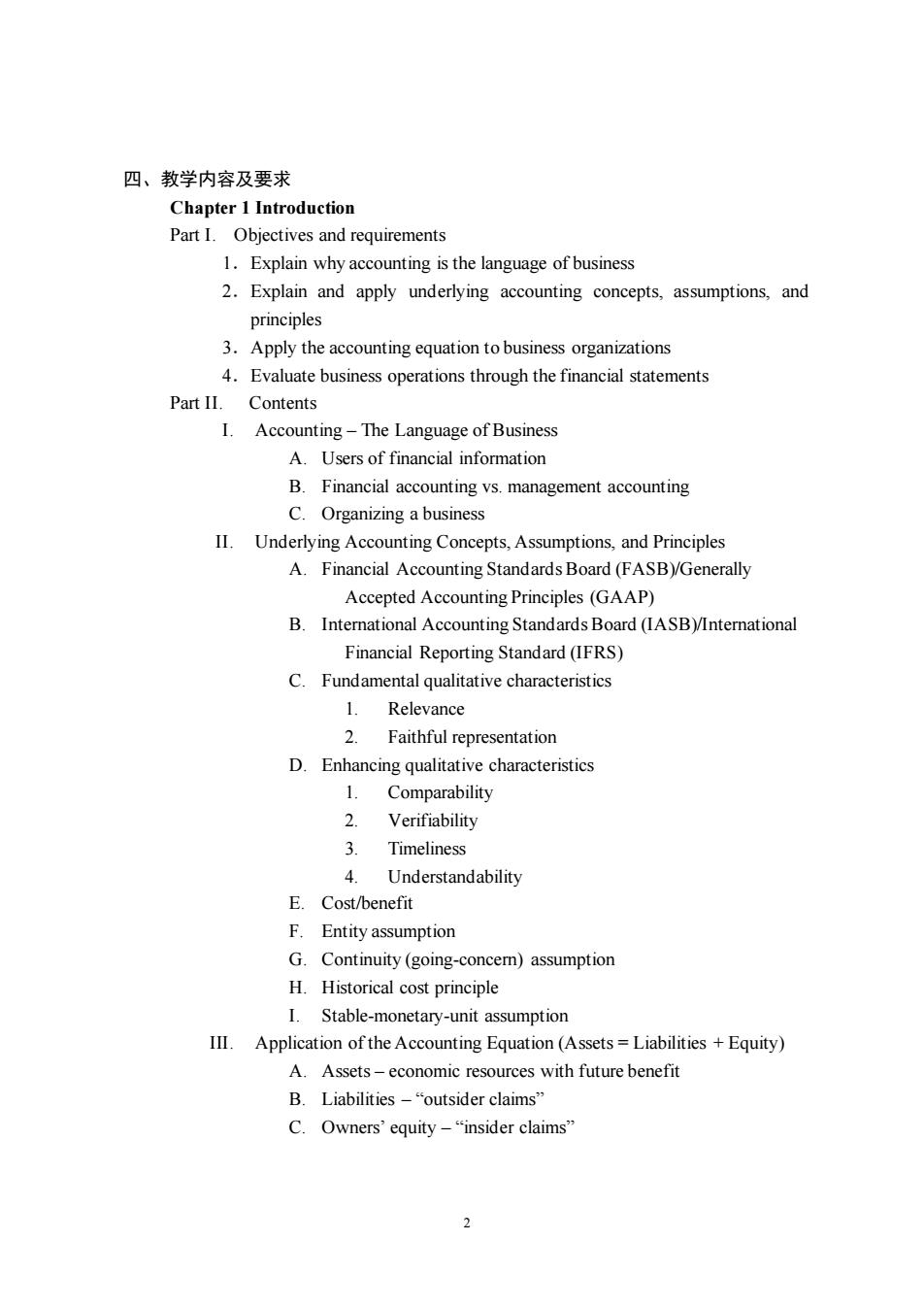
四、教学内容及要求 Chapter 1 Introduction Part I.Objectives and requirements 1.Explain why accounting is the language of business 2.Explain and apply underlying accounting concepts,assumptions,and principles 3.Apply the accounting equation to business organizations 4.Evaluate business operations through the financial statements Part II.Contents I.Accounting-The Language of Business A.Users of financial information B.Financial accounting vs.management accounting C.Organizing a business II.Underlying Accounting Concepts,Assumptions,and Principles A.Financial Accounting Standards Board(FASB)/Generally Accepted Accounting Principles (GAAP) B.Intemnational Accounting Standards Board(IASB)Interational Financial Reporting Standard (IFRS) C.Fundamental qualitative characteristics Relevance Faithful representation D.Enhancing qualitative characteristics 1 Comparability 2. Verifiability 3 Timeliness 4. Understandability E.Cost/benefit F.Entity assumption G.Continuity(going-concem)assumption H.Historical cost principle I.Stable-monetary-unit assumption III.Application of the Accounting Equation(Assets=Liabilities +Equity) A.Assets-economic resources with future benefit B.Liabilities-“outsider claims'” C.Owners'equity-"insider claims
2 四、教学内容及要求 Chapter 1 Introduction Part I. Objectives and requirements 1.Explain why accounting is the language of business 2.Explain and apply underlying accounting concepts, assumptions, and principles 3.Apply the accounting equation to business organizations 4.Evaluate business operations through the financial statements Part II. Contents I. Accounting – The Language of Business A. Users of financial information B. Financial accounting vs. management accounting C. Organizing a business II. Underlying Accounting Concepts, Assumptions, and Principles A. Financial Accounting Standards Board (FASB)/Generally Accepted Accounting Principles (GAAP) B. International Accounting Standards Board (IASB)/International Financial Reporting Standard (IFRS) C. Fundamental qualitative characteristics 1. Relevance 2. Faithful representation D. Enhancing qualitative characteristics 1. Comparability 2. Verifiability 3. Timeliness 4. Understandability E. Cost/benefit F. Entity assumption G. Continuity (going-concern) assumption H. Historical cost principle I. Stable-monetary-unit assumption III. Application of the Accounting Equation (Assets = Liabilities + Equity) A. Assets – economic resources with future benefit B. Liabilities – “outsider claims” C. Owners’ equity – “insider claims
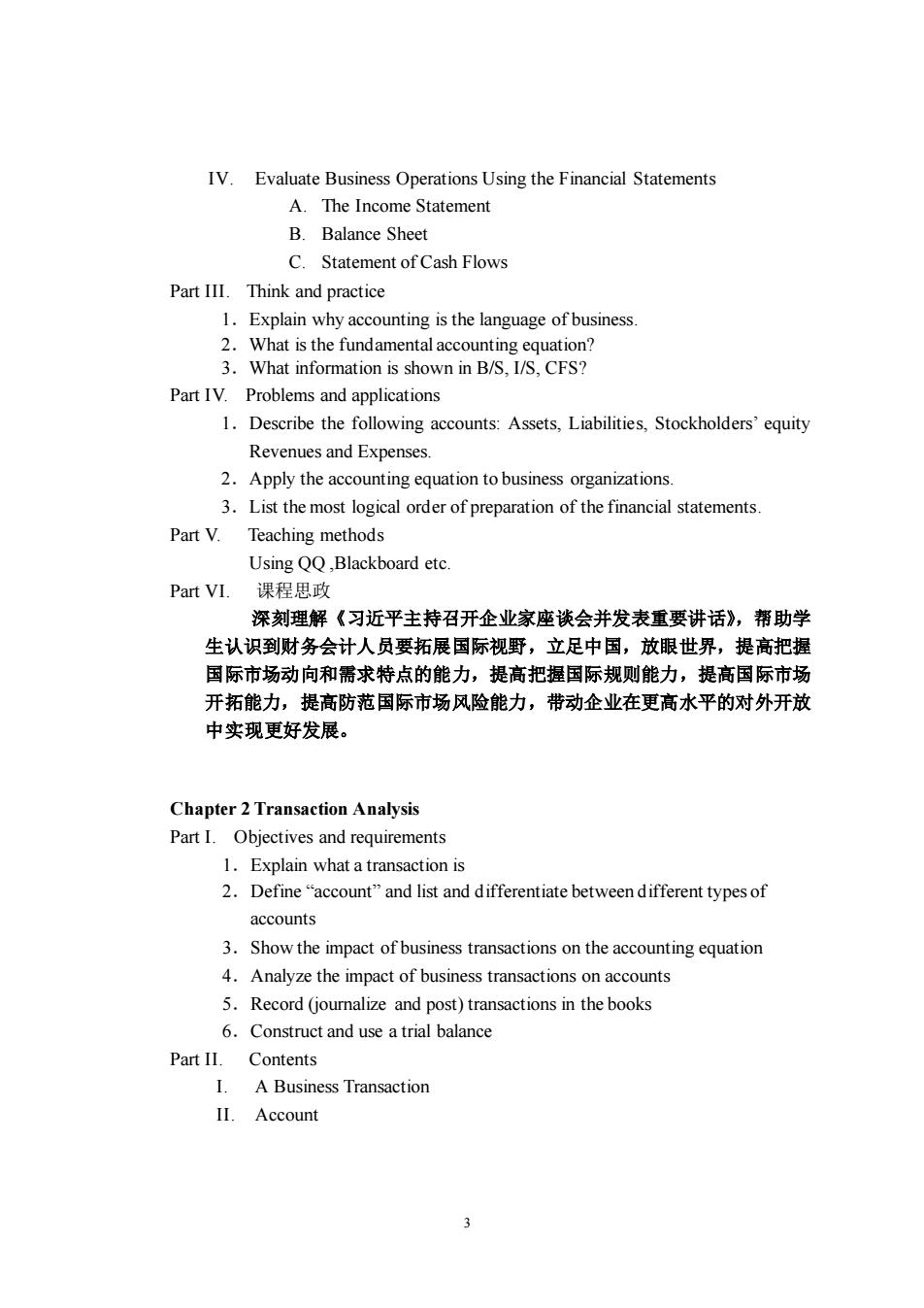
IV.Evaluate Business Operations Using the Financial Statements A.The Income Statement B Balance Sheet C.Statement of Cash Flows Part III.Think and practice 1.Explain why accounting is the language of business 2.What is the fundamental accounting equation? 3.What information is shown in B/S,I/S,CFS? Part IV.Problems and applications 1.Describe the following accounts:Assets,Liabilities,Stockholders'equity Revenues and Expenses 2.Apply the accounting equation to business organizations. 3.List the most logical order of preparation of the financial statements Part V.Teaching methods Using QQ,Blackboard etc. Part VI. 课程思政 深刻理解《习近平主持召开企业家座谈会并发表重要讲话》,帮助学 生认识到财务会计人员要拓展国际视野,立足中国,放眼世界,提高把握 国际市场动向和需求特点的能力,提高把握国际规则能力,提高国际市场 开拓能力,提高防范国际市场风险能力,带动企业在更高水平的对外开放 中实现更好发展。 Chapter 2 Transaction Analysis Part 1.Objectives and requirements 1.Explain what a transaction is 2.Define"account"and list and differentiate between different types of accounts 3.Show the impact of business transactions on the accounting equation 4.Analyze the impact of business transactions on accounts 5.Record(jouralize and post)transactions in the books 6.Construct and use a trial balance Part II.Contents I.A Business Transaction II.Account 3
3 IV. Evaluate Business Operations Using the Financial Statements A. The Income Statement B. Balance Sheet C. Statement of Cash Flows Part III. Think and practice 1.Explain why accounting is the language of business. 2.What is the fundamental accounting equation? 3.What information is shown in B/S, I/S, CFS? Part IV. Problems and applications 1.Describe the following accounts: Assets, Liabilities, Stockholders’ equity Revenues and Expenses. 2.Apply the accounting equation to business organizations. 3.List the most logical order of preparation of the financial statements. Part V. Teaching methods Using QQ ,Blackboard etc. Part VI. 课程思政 深刻理解《习近平主持召开企业家座谈会并发表重要讲话》,帮助学 生认识到财务会计人员要拓展国际视野,立足中国,放眼世界,提高把握 国际市场动向和需求特点的能力,提高把握国际规则能力,提高国际市场 开拓能力,提高防范国际市场风险能力,带动企业在更高水平的对外开放 中实现更好发展。 Chapter 2 Transaction Analysis Part I. Objectives and requirements 1.Explain what a transaction is 2.Define “account” and list and differentiate between different types of accounts 3.Show the impact of business transactions on the accounting equation 4.Analyze the impact of business transactions on accounts 5.Record (journalize and post) transactions in the books 6.Construct and use a trial balance Part II. Contents I. A Business Transaction II. Account
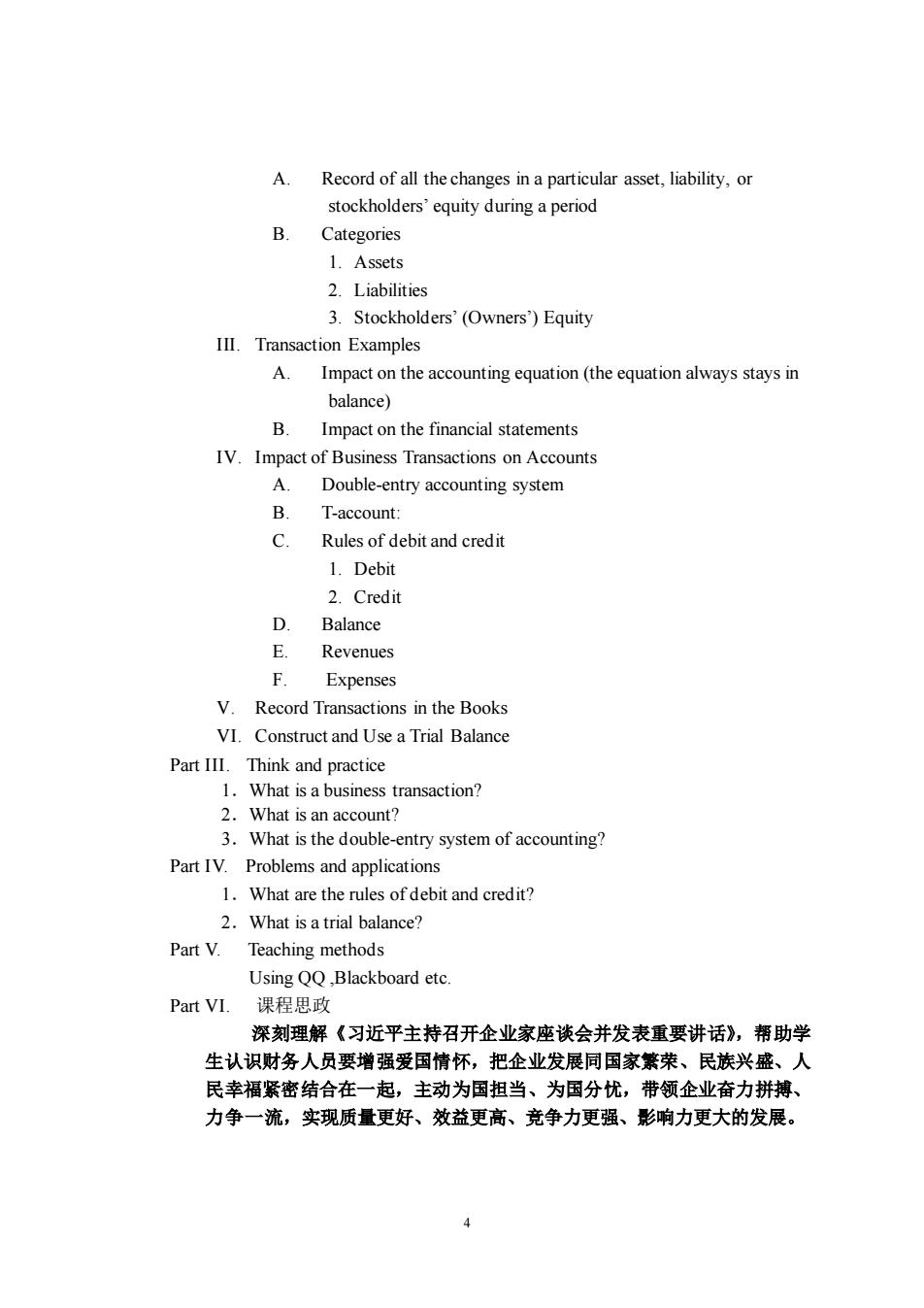
A.Record of all the changes in a particular asset,liability,or stockholders'equity during a period B.Categories 1.Assets 2.Liabilities 3.Stockholders'(Owners)Equity III.Transaction Examples A. Impact on the accounting equation(the equation always stays in balance) B. Impact on the financial statements IV.Impact of Business Transactions on Accounts A Double-entry accounting system B. T-account: C. Rules of debit and credit 1 Debit 2.Credit D Balance 6 Revenues F Expenses V.Record Transactions in the Books VI.Construct and Use a Trial Balance Part III.Think and practice 1.What is a business transaction? 2 What is an ac unt? 3.What is the doub-enysystem of ccounting? Part IV.Problems and applications 1.What are the rules of debit and credit? 2.What is a trial balance? Part V. Teaching methods Using OO Blackboard etc Part VI. 课程思政 深刻理解《习近平主持召开企业家座谈会并发表重要讲话》,帮助学 生认识财务人员要增强爱国情怀,把企业发展同国家繁荣、民族兴盛、人 民幸福紧密结合在一起,主动为国担当、为国分忧,带领企业奋力拼搏、 力争一流,实现质量更好、效益更高、竞争力更强、形响力更大的发展。 4
4 A. Record of all the changes in a particular asset, liability, or stockholders’ equity during a period B. Categories 1. Assets 2. Liabilities 3. Stockholders’ (Owners’) Equity III. Transaction Examples A. Impact on the accounting equation (the equation always stays in balance) B. Impact on the financial statements IV. Impact of Business Transactions on Accounts A. Double-entry accounting system B. T-account: C. Rules of debit and credit 1. Debit 2. Credit D. Balance E. Revenues F. Expenses V. Record Transactions in the Books VI. Construct and Use a Trial Balance Part III. Think and practice 1.What is a business transaction? 2.What is an account? 3.What is the double-entry system of accounting? Part IV. Problems and applications 1.What are the rules of debit and credit? 2.What is a trial balance? Part V. Teaching methods Using QQ ,Blackboard etc. Part VI. 课程思政 深刻理解《习近平主持召开企业家座谈会并发表重要讲话》,帮助学 生认识财务人员要增强爱国情怀,把企业发展同国家繁荣、民族兴盛、人 民幸福紧密结合在一起,主动为国担当、为国分忧,带领企业奋力拼搏、 力争一流,实现质量更好、效益更高、竞争力更强、影响力更大的发展
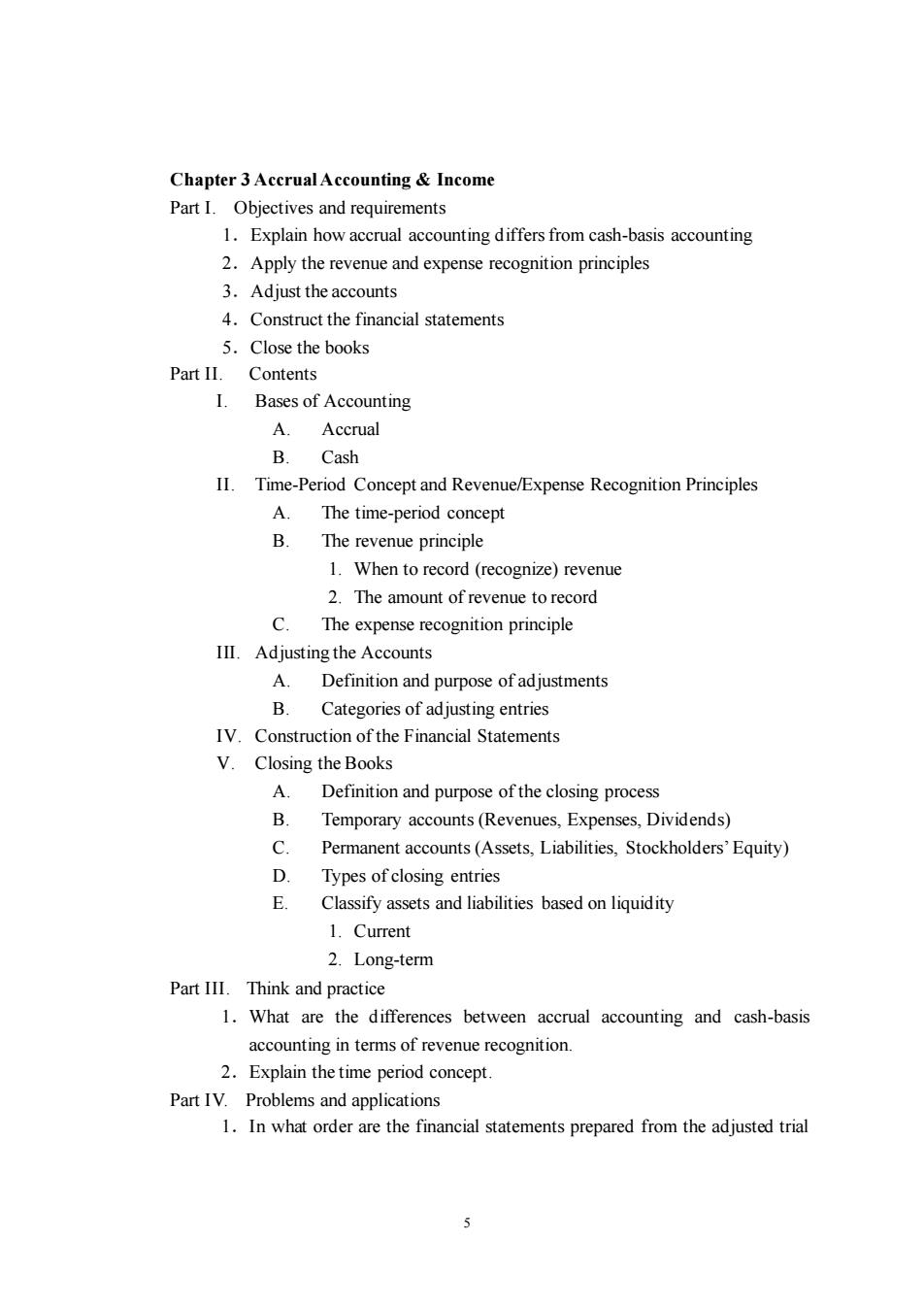
Chapter 3 Accrual Accounting Income Part I.Objectives and requirements 1.Explain how accrual accounting differs from cash-basis accounting 2.Apply the revenue and expense recognition principles 3.Adiust the accounts 4.Construct the financial statements 5.Close the books Part II. Contents I.Bases of Accounting Accrual B Cash II.Time-Period Concept and Revenue/Expense Recognition Principle A The time-period concept B The revenue principle 1.When to record(recognize)revenue 2.The amount of revenue to record The expense recognition principle III.Adjusting the Accounts A Definition and purpose ofadjustments B Categories of ad justing entries IV.Construction of the Financial Statements V.Closing the Books A Definition and purpose of the closing process Temporary accounts (Revenues.Expenses,Dividends) Permanent accounts(Assets,Liabilities,Stockholders'Equity) D Types of closing entries E Classify assets and liabilities based on liquidity 1.Current 2.Long-term Part III.Think and practice 1.What are the differences between accrual accounting and cash-basis accounting in terms of revenue recognition. 2.Explain the time period concept Part IV.Problems and applications 1.In what order are the financial statements prepared from the adjusted trial 5
5 Chapter 3 Accrual Accounting & Income Part I. Objectives and requirements 1.Explain how accrual accounting differs from cash-basis accounting 2.Apply the revenue and expense recognition principles 3.Adjust the accounts 4.Construct the financial statements 5.Close the books Part II. Contents I. Bases of Accounting A. Accrual B. Cash II. Time-Period Concept and Revenue/Expense Recognition Principles A. The time-period concept B. The revenue principle 1. When to record (recognize) revenue 2. The amount of revenue to record C. The expense recognition principle III. Adjusting the Accounts A. Definition and purpose of adjustments B. Categories of adjusting entries IV. Construction of the Financial Statements V. Closing the Books A. Definition and purpose of the closing process B. Temporary accounts (Revenues, Expenses, Dividends) C. Permanent accounts (Assets, Liabilities, Stockholders’ Equity) D. Types of closing entries E. Classify assets and liabilities based on liquidity 1. Current 2. Long-term Part III. Think and practice 1.What are the differences between accrual accounting and cash-basis accounting in terms of revenue recognition. 2.Explain the time period concept. Part IV. Problems and applications 1.In what order are the financial statements prepared from the adjusted trial